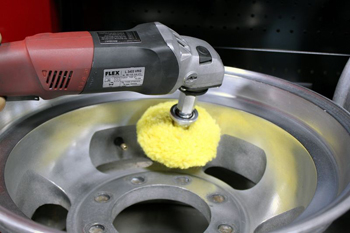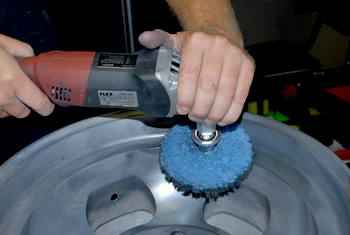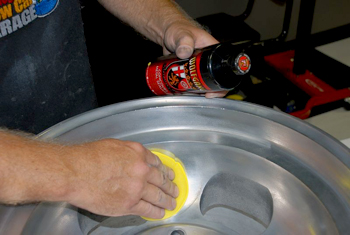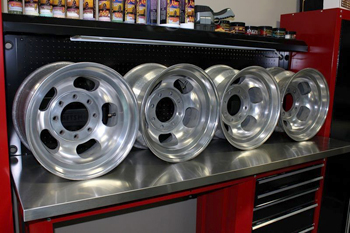
How To Clean and Polish Bare Aluminum Wheels
When cleaned and polished, aluminum wheels have the potential to shine like chrome. Aluminum is a relatively soft metal, which means it responds well to polishing. Cleaning and polishing aluminum is very rewarding and it is an absolute must if you want to keep aluminum wheels looking like new.
Bare aluminum has a tendency to oxidize. Oftentimes, OEM aluminum wheels have a protective coating on top to prevent aluminum oxide. In the case of coated aluminum, you'll need wheel cleaners and polishes that are safe on coatings. On the other hand, if your aluminum wheels have no coating, you can afford to use a stronger aluminum polish. This guide is intended for bare aluminum wheels.
Note: You can tell if there is a coating on aluminum by applying a little polish in an inconspicuous spot. As you rub, if no black residue appears, there is a coating over the aluminum. Aluminum oxide comes off as a black residue if you're working on uncoated aluminum. If you think they may be clear coated, see our guide entitled, How To Clean and Polish Clear Coated Wheels.
Wheels' worst enemy
Brake dust is made of an adhesive and carbon fibers that come off the brake pad and tiny metal shavings from the rotor. The intense heat and friction generated by the wheels makes this mixture highly corrosive. Because you probably drive every day, more brake dust is constantly being made. Frequent cleaning is the only way to keep your wheels safe from pitting and corrosion.
Step by Step
We recommend cleaning the wheels before washing your vehicle. Cleaning wheels first will prevent brake dust and dirty water from splashing onto a clean car.
- Rinse aluminum wheels to remove loose dirt and brake dust. Use a Fireman's Nozzle to deliver a strong stream of water. Be sure to rinse between spokes, the brake calipers, and behind the wheels. Remember, brake dust can creep into every little crevice.
- Spray one wheel at a time with an aluminum wheel cleaner. A few examples are SONAX Wheel Cleaner Full Effect, Detailer's Pro Series Wheel Cleaner, and P21S Gel Wheel Cleaner. These cleaners are non-acidic in order to clean effectively without spotting the wheel.
- Use a soft bristled wheel brush to agitate the wheel. Even if you're going to polish next, resist the temptation to use an aggressive brush. Stiff bristles may scratch the aluminum and then you may have to work harder to remove them with a polish. The Speed Master Wheel Brush is a great choice because it can fit narrow or wide spaces and has a flexible stem. The soft, synthetic bristles loosen grime and brake dust without scratching the wheel finish. Reach through spokes to clean the barrel front to back.
- Don't forget the lug nuts. Brake dust hides wherever it can. Use a lug nut brush to clean around the lug nuts and inside the lug nut holes. While you're working with the brushes, the wheel should remain wet. The water and wheel cleaner help loosen grime, but they also lubricate the wheel surface to prevent scratching. You never you want to let a wheel cleaner dry on the wheel because it will spot the finish.
- While you're down there, clean the wheel wells, a.k.a. fender wells. A lot of dirt and mud is kicked up in the wheel wells as the tires roll. You might need something a bit stronger than what you used on the wheels. Spray the wheel well generously with an all purpose cleaner, like Detailer's Pro Series Cleanse-All Exterior Surface Cleaner. Use a long handled brush with sturdy bristles to agitate the wheel well. Note: Do not use your soft wheel brush on the wheel wells. Likewise, do not use the wheel well brush on the wheel itself. Think soft and gentle for wheels, strong and sturdy for wheel wells.
- Rinse the wheel and wheel well, including the lug nut holes and between the spokes.
- Always dry wheels. Water spots are unattractive wherever they appear, even on the wheels. Our Wheel & All Purpose Microfiber Towel is exceptionally gentle on the wheel finish and grabs any residual brake dust. Because the towel is black, you can you use it on wheels without ruining it. To avoid cross-contamination, use this towel only on wheels and wash it separately from your other microfiber towels. Brake dust is the last thing you want on your paint!
Clay Aluminum Wheels
All the tiny contaminants that stick to your vehicle's body also stick to the wheels. Even though aluminum is harder than clear coated or painted wheels, tiny airborne contaminants can pierce the metal wheel surface. Plus, brake dust is ever present. Detailing clay is a fantastic tool for removing embedded contamination from wheels. Griot's Garage Wheel Cleaning Clay is made especially for claying wheels. The good thing about this product is that you have a clearly labeled jar so it's less likely you'll confuse the wheel clay with the regular detail clay you use on the paint. You should not mix them up! Always avoid cross-contamination between wheels and paint.
Always use wheel detailing clay after cleaning the wheel but before polishing or waxing.
- Spray the wheel generously with Griot's Garage Speed Shine or another slippery clay lubricant.
- Take a quarter of the clay bar and flatten it into a patty over your fingers. Then rub the clay over the wheel. Take care to get between spokes and wherever you can see pitting or black spots.
- Fold the clay to reveal a clean side as it becomes soiled.
- When you're done with each wheel, use the clay lubricant or quick detailer to remove any clay residue and wipe the wheel clean.
- Do the same on all four wheels.
Wheel Polishing
|
Stop here if you think your wheels may have a coating and click over to our How To Clean and Polish Clear Coated Wheels guide.
For aluminum wheels, which have no top coating, you can afford to use a polish with some bite. You'll need it to remove the aluminum oxide. Aluminum can tarnish and rust, unlike clear coated alloy, so these polishes are equipped to remove oxidation. For explanation purposes, we'll use the Wolfgang Metallwerk Aluminum System as an example. Oxidized aluminum often needs multiple steps to restore a mirror shine.
For the best results, apply metal polishes to the wheels with a polisher. In this example, we're using a FLEX L3403 VRG Lightweight Rotary Polisher with Cyclo Wool Pads. Use the 3M Quick Release Adaptor to connect the pads to the polisher. The 4 inch pads will allow you to cut through heavy oxidation on the wheel face. You may need to work between the spokes with Wolfgang Finger Pockets.
- Before we get started with Wolfgang, we need to remove any thick oxidation with Flitz Aluminum PreClean. This cleaner takes some of the work out of removing the really heavy oxidation, though it doesn't replace polishing. Spray Flitz Aluminum PreClean onto the wheel and let it sit for 7-10 minutes. Use a brush to agitate the surface where needed. Then rinse well with water. Dry the wheels before polishing.
-
Wipe Wolfgang Metallwerk Aluminum Compound onto the wheel. Work on one wheel at a time.![Use a yellow compounding pad to apply Wolfgang Metallwerk Aluminum Compound.]()
Use a wool pad, such as the Cyclo DoublePrecision Medium Cut Wool Pad, to apply Wolfgang Metallwerk Aluminum Compound.![Apply Wolfgang Metallwerk Fine Aluminum Polish with a blue wool pad.]()
Next apply Wolfgang Metallwerk Fine Aluminum Polish with a Cyclo DoublePrecision Blue Finishing Wool Pad.![Apply Wolfgang Metallwerk Concours Metal Sealant to protect aluminum wheels.]()
Always apply wheel protection, such as Wolfgang Metallwerk Concours Metal Sealant. - With your yellow 4 inch wool pad attached to your polisher, start slowly and spread the polish over the wheel. Gradually increase the speed up to 3000 RPM. Keep the pad moving over the wheel until the polish starts to dry or diminish.
- Use a soft, clean microfiber towel to wipe the wheel clean.
- Next, use Wolfgang Metallwerk Fine Aluminum Polish to refine the wheel finish. This works just like a multi-step process for the paint. Start with your most aggressive polish and then a lighter polish to refine the shine. Spread Wolfgang Fine Aluminum Polish over the wheel using a foam or microfiber applicator pad.
- Using a clean blue wool pad on your drill, polish slowly to spread the metal polish over the wheel. Then gradually increase the speed up to 3000 rpm and thoroughly polish the wheel until the polish starts to dry or diminish.
- Wipe the wheel clean with a microfiber towel. The wheel should be in great shape at this point. If you're not quite satisfied with the shine, repeat the process with Wolfgang Fine Aluminum Polish.
- Now most people would be happy to stop here, but we know there are those of you who have to go the extra mile when it comes to your car. Totally understandable! So, for you perfectionists, there is Wolfgang Metallwerk Concours Aluminum Polish. It's an ultra fine polish that puts a mirror shine on aluminum. Wipe it on using a foam or microfiber applicator.
- Using a clean blue wool pad on your drill, polish slowly to spread the metal polish over the wheel. Then gradually increase the speed up to 3000 rpm and thoroughly polish the wheel until the polish starts to dry or diminish.
- Buff the wheel clean with a clean microfiber towel. Note: Every time you remove polish residue with a microfiber towel, some of the polish is stuck in the towel. Therefore, you always want to buff off a new polish with a new towel to avoid wiping the previous polish back on the wheel.
- Repeat the above process on all four wheels.
Wax aluminum wheels
Once you've got your wheels looking flawless, apply Wolfgang Metallwerk Concours Metal Sealant to protect the aluminum and help prevent oxidation. It's made for all metals.
You can also use a wheel-specific protectant like Detailer's Pro Series Wheel Glaze or Wheel Wax to seal the wheel surface. These products work just like car wax. Apply them with an applicator pad and then buff the wheel. They keep your wheels looking shiny, and they prevent brake dust adhesion. Your wheels look cleaner longer. You have to reapply these products weekly, but it's better than scrubbing your wheels every two days. The good news is, if you use a wheel wax as recommended, water is the only thing you need to clean your wheels between waxings.
|
|
Tire dressing the finishing touch
Choose your tire dressing carefully. Old-fashioned tire dressings contain silicone, which produces a glossy shine but it turns brown over time. In fact, shiny silicone tire dressings can attract dirt. These dressings deplete the rubber's plasticizers faster, causing it to age prematurely. Newer formulas, like Pinnacle Black Onyx Tire Gel or Optimum Opti-Bond Tire Gel, are water-based and less shiny, but less shiny is the concours look you want. These dressings create the look of new tires with a semi-gloss sheen that doesn't turn brown. Pinnacle Black Onyx Tire Gel also nourishes the rubber to recreate the look of new tires. You can often layer water-based dressings to get a glossier shine. Follow the directions on the label carefully. Always apply thin coats and allow drying time before you drive your vehicle. Even the best dressing will sling off if it's on too thick or it doesn't have time to dry. Avoid pooling of the dressing around raised letters and white walls.






